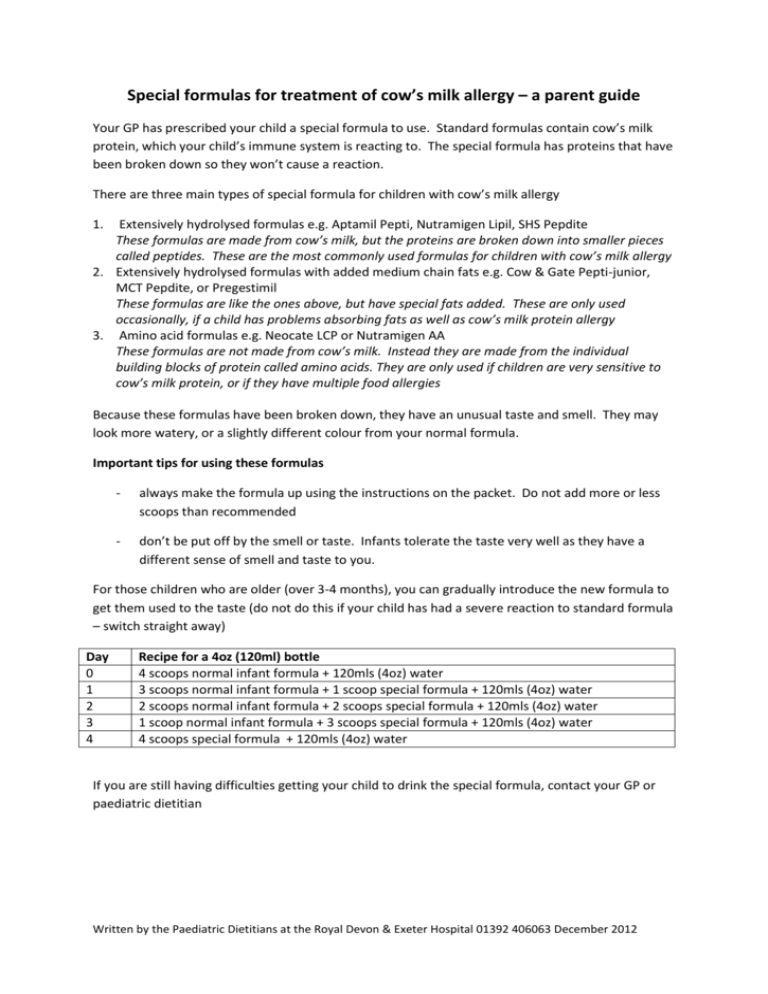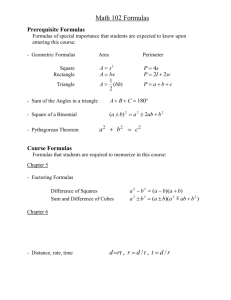1f_Parent info special formulas for treatment of cows milk protein
advertisement

Special formulas for treatment of cow’s milk allergy – a parent guide Your GP has prescribed your child a special formula to use. Standard formulas contain cow’s milk protein, which your child’s immune system is reacting to. The special formula has proteins that have been broken down so they won’t cause a reaction. There are three main types of special formula for children with cow’s milk allergy 1. Extensively hydrolysed formulas e.g. Aptamil Pepti, Nutramigen Lipil, SHS Pepdite These formulas are made from cow’s milk, but the proteins are broken down into smaller pieces called peptides. These are the most commonly used formulas for children with cow’s milk allergy 2. Extensively hydrolysed formulas with added medium chain fats e.g. Cow & Gate Pepti-junior, MCT Pepdite, or Pregestimil These formulas are like the ones above, but have special fats added. These are only used occasionally, if a child has problems absorbing fats as well as cow’s milk protein allergy 3. Amino acid formulas e.g. Neocate LCP or Nutramigen AA These formulas are not made from cow’s milk. Instead they are made from the individual building blocks of protein called amino acids. They are only used if children are very sensitive to cow’s milk protein, or if they have multiple food allergies Because these formulas have been broken down, they have an unusual taste and smell. They may look more watery, or a slightly different colour from your normal formula. Important tips for using these formulas - always make the formula up using the instructions on the packet. Do not add more or less scoops than recommended - don’t be put off by the smell or taste. Infants tolerate the taste very well as they have a different sense of smell and taste to you. For those children who are older (over 3-4 months), you can gradually introduce the new formula to get them used to the taste (do not do this if your child has had a severe reaction to standard formula – switch straight away) Day 0 1 2 3 4 Recipe for a 4oz (120ml) bottle 4 scoops normal infant formula + 120mls (4oz) water 3 scoops normal infant formula + 1 scoop special formula + 120mls (4oz) water 2 scoops normal infant formula + 2 scoops special formula + 120mls (4oz) water 1 scoop normal infant formula + 3 scoops special formula + 120mls (4oz) water 4 scoops special formula + 120mls (4oz) water If you are still having difficulties getting your child to drink the special formula, contact your GP or paediatric dietitian Written by the Paediatric Dietitians at the Royal Devon & Exeter Hospital 01392 406063 December 2012 What to expect when you switch over to the special formula 1. It often takes a few weeks for symptoms to resolve after you have swapped formulas – but let your GP know if your child’s symptoms are not improving after a fortnight 2. These special formulas can turn your child’s poo darker (sometimes greenish). The amount and consistency of the poo may also change - this is normal Did you know? When your child starts to wean onto solid foods, you can use their special formula as a milk substitute in cooking e.g. to make milk free custard, or to mix with cereals for breakfast. A paediatric dietitian can give you recipe ideas. These formulas are only available on prescription from your GP. You cannot buy them in the pharmacy or supermarket. For this reason, you need to make sure you request a repeat prescription in plenty of time, so you don’t run out. When to expect your GP to review your prescription of special formula 1. After a trial of a special formula 2. if the special formula is not improving your child’s symptoms 3. If you accidentally give your child milk and they have no symptoms 4. After any recommended challenges to milk 5. At 2 years of age (most children who remain allergic to cow’s milk can move on to a supermarket milk replacement drink at 2 years e.g. calcium fortified soya milk) Written by the Paediatric Dietitians at the Royal Devon & Exeter Hospital 01392 406063 December 2012




